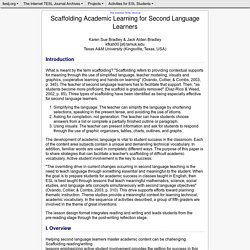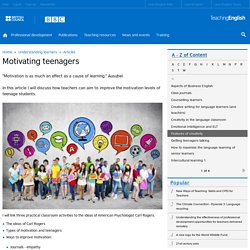

M.Ed. in Differentiation - Sample Lesson. Understanding Differentiated Instruction: Building a Foundation for Leadership. Total physical response - TPR. Bradley - Scaffolding Academic Learning for Second Language Learners. The Internet TESL Journal Karen Sue Bradley & Jack Alden Bradleykfksb00 [at] tamuk.eduTexas A&M University (Kingsville, Texas, USA) Introduction What is meant by the term scaffolding?

"Scaffolding refers to providing contextual supports for meaning through the use of simplified language, teacher modeling, visuals and graphics, cooperative learning and hands-on learning" (Ovando, Collier, & Combs, 2003, p. 345). The teacher of second language learners has to facilitate that support. IATEFL 2018: Safe Speaking Environments - What? Why? How? Published 9 April 2018 In our first post from IATEFL 2018, we’re sharing the talk from Professor of Psycholinguistics, Zoltán Dörnyei, on what exactly Safe Speaking Environments are and why you should care.

The talk looks at creating a psychological environment in the classroom which might make students’ lives easier. Zoltán says that in order to facilitate speaking in the language classroom, we need to: Create suitable conditions in accordance with the main tenets of group dynamics, andApply the principles of safe speaking environments What conditions need to be in place so we can start implementing a safe speaking environment? Zoltán talks about group cohesiveness being a very important attribute, which determines the productivity of the group, and the degree of members’ engagement with the group.
He looks at eight different factors that promote group cohesiveness, including cooperation, competition and teachers’ leadership styles. 1. 2. 3. See more recordings and articles from IATEFL. IATEFL 2018: Safe Speaking Environments - What? Why? How? Motivating speaking activities for lower levels. Planning time has been shown to increase production in speaking tasks. Lower level learners often find it especially difficult to speak spontaneously, so these activities incorporate 'thinking time' during which learners can prepare for speaking by planning what they are going to say, and asking the teacher or using a dictionary to look up missing vocabulary.
The following activities are relatively short, with minimal materials preparation time for the teacher. They are designed for use as a warmer or a filler in the middle or at the end of a class. 1. Definitions lists This activity is good for activating existing vocabulary or revising vocabulary studied in previous lessons. Procedure. Motivating the unmotivated. Motivating teenagers. I will link three practical classroom activities to the ideas of American Psychologist Carl Rogers.

The ideas of Carl Rogers Types of motivation and teenagers Ways to improve motivation:Journals - empathy Using photos - authenticity Music - acceptance The ideas of Carl Rogers Rogers (1957) outlined 3 attitudinal qualities that a teacher, or in his words, a facilitator, should have to assist the learning process. They are empathy (seeing things from the students' viewpoint), authenticity (being yourself) and acceptance (of students' ideas and opinions). Types of motivation and teenagers It is widely agreed that motivation has a great effect on a student's capacity to learn.
Motivation can be broken down into extrinsic and intrinsic forms. Equal opportunity and diversity: The handbook for teachers of English. UL Differentiating tasks. UL successful speaking activities. Top ten time-management tips for teachers. I often hear teachers in staffrooms complaining about students who are late for lessons and claim they have no time to complete their homework tasks, and yet spend their waking hours on social media and binge-watching series after series on Netflix.

Then there are teachers who sneer at me when I talk about CPD (Continuing Professional Development) and categorically tell me that they have time for no such thing. There is no doubt that time-management is a skill that we are not born with and like any other skill, takes time (ironic, I know!) To hone. In the recent issue of English Teaching professional (114), I took a brief look at how we could (and should) include the teaching of time management in our classes, and suggested that many teachers could do with some help in this area.
What to consider when teaching English in large classes. How many students do you teach? Do you feel that your classes are too big? Author and education consultant Jason Anderson looks at the issues and offers some potential solutions. For many of us, our classes are larger than we would like them to be. They can present a number of challenges that teachers of smaller classes are less likely to face. ClassroomScreen. Random Name Picker. Random Name Picker. 9 Strategies for Encouraging More Students to Talk in Class. While it is possible to learn by listening, I’ve found that oral participation leads to greater gains in student literacy and engagement.

English language learners in particular benefit from ample talk time, but they are not the only ones. Yet I’ve also found that without careful planning, a few students do most of the talking while the majority of the class remains silent. My students all have ideas, but only some of them share those ideas on a regular basis. Adding wait time after I ask a question helps more students get into the conversation, but still the more confident students are more likely to raise their hands. Because of this, I pay close attention to who is participating in my high school English classroom and to the structures I’m using to promote participation. 9 Ways to Encourage More Students to Talk 1. 2. 3. They talk in their pairs from bell to bell between direct instruction about the topics of the day. 4. 5. 6. 7. 8.